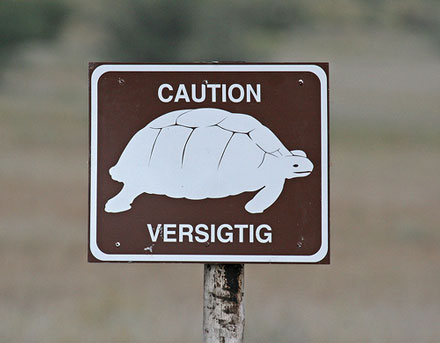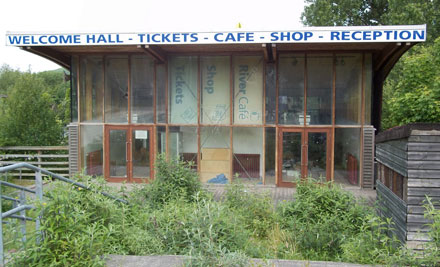By Nathan Oxley, Communications Officer, STEPS Centre
Peace Parks sound lovely, don’t they? I mean, who would be against the idea of creating a nature reserve across national borders to promote co-operation, development and conservation?

Sign in Kgalagadi Transfrontier Park, Northern Cape, South Africa
Bram Büscher (Institute of Social Studies), who gave a STEPS Centre Seminar last week, has been delving into the reality of this global phenomenon, focusing on a series of parks in Southern Africa (he also has a book just out). The basic idea is that you designate a zone across a national boundary (say, South Africa and Lesotho), and put particular effort into nature conservation, community development and tourism in those areas, building links between the countries. For example, the World Cup in 2010 was a golden opportunity for transboundary parks in Southern Africa to be promoted to a global audience – encouraging travel around the whole region.
Despite the good intentions and effort involved, Büscher’s talk showed some of the difficulties of making such projects work for local people. There were a lot of ideas and interesting anecdotes in the talk which I won’t go into – the full audio on the event page is well worth a listen. But a couple of things leapt out at me.
Where interests clash
Throughout the whole story, there is the difficulty of doing conservation and community development at the same time – organising meetings with local people, whose own life experiences – sometimes traumatic or difficult – often intrude into the best-planned agendas.
Local people also don’t always want the golf courses or other ‘developments’ offered by planners; or they might already use the land in ways that clash with the ideas of conservation embedded in the project.
Antipolitics
Büscher also offered a nicely-expressed summary of various types of ‘antipolitics’, which he defined as “constructing reality such that it seems not to be debatable but ‘taken for granted’ or the ‘logical choice’”. Beyond the particular scenario of Peace Parks, this idea is uncomfortably familiar, even among well-meaning promoters of ‘sustainable’ solutions and futures who present their agenda as a ‘no-brainer’.
In his talk, Büscher gave two striking examples of antipolitics. First, plans and ‘grids’ (extensive tables in planning documents) are used instrumentally to iron out differences. You can see why this might be desirable, from the project manager’s point of view. The second example is the use of participatory processes. There are cases (though not always) where the ‘inclusion’ begins and ends with a participatory meeting or two.
Marketing and the ‘win-win’
Peace Parks claim to offer a ‘win-win’: one of these wins being for the local people, who are promised better economic links, and another for the plants and animals in the area. Other ‘wins’, like tourism and diplomatic relations, also come into it. You might expect some conflict and contestation between these things.
But even when the planners of the projects Büscher looked at were aware of these conflicts, it sometimes appeared that their response was to take refuge in grand promises and marketing discourse. It’s not that conflict is ignored – rather, it’s swept up in the marketing exercise which promises to address it.
Getting swept up in the brand
Beyond Peace Parks, what does this mean for marketing and sustainability in general? I’m going to offer an idea of how this could work in any big project with a grand plan to change the world. Here’s what can happen: the brand pushes in two directions, internal and external.
- Internal: the ‘brand’ and the ‘story’ is internalised (it becomes more real, as an idealised vision, for the project’s partners than whatever’s happening on the ground)
- External: the brand and messages are marketed to the outside world and take on a life of their own, beyond the project’s direct control, as they are taken up and responded to by different audiences. We are in the realm of public expectation, media coverage, even (perhaps) public protest and resistance, and so on.
For anyone involved in the interface between branding and sustainability, this is a cautionary tale. In my limited experience of that world, this is a known problem, even if it’s not expressed in this way. Branding agencies that take sustainability seriously are – to greater or lesser extents – aware of the possibility of getting swept up in the grand narrative, and take action to mitigate against them. For example, they might emphasise the importance of honesty in a project and make extra efforts to keep in touch with what is happening on the ground.
Ambition and excitement, so important in big projects, is hard to control. Ironically perhaps, I think this is a particular problem for so-called ‘ethical’ or ‘sustainable’ ventures – especially in tourism and other land-based ventures. But anyone involved in creative communications about sustainability should know the risks here. There are plenty of examples where this has gone wrong, despite good intentions.

The abandoned ticket office at the Earth Centre, UK
Big stories and little stories
What about the rest of us? Grand narratives are all around us like an invisible web. Of course we use stories to make sense of the world, it’s part of being human. One way to deal with this is to shine light on the stories themselves, to dismantle them and refashion them.
Also – to put it simplistically – there are big stories and little stories. People on the margins – what they want, and the different possible futures they see for themselves – are as deserving of our attention as the grand narratives that shape our lives.
Images: Watch out for tortoises by wildlifewanderer on Flickr / Earth Centre ticket office from http://welovetheearthcentre.blogspot.co.uk/